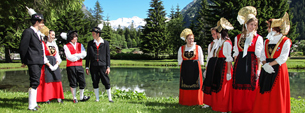The Roman Age in the Aosta Valley - RU
In the Aosta Valley, the Roman presence is evoked by many, well-preserved monuments
The Roman Empire rules
The Roman Empire conquered the Aosta Valley during Augustus' reign, when relations intensified between the Empire and North Gaul, leading to the borders being extended towards the Germanic area.
After a series of military initiatives against the mountain population, including the Salassi (a Celtic-Ligurian race whici lived in the Aosta Valley), Aulo Terenzio Varrone gained definitive victory in 25 B.C. Part of the local population was annihilated or reduced to slavery, but certain groups integrated into the new Roman society, which lead to a limited merging of the races. Elements of mutual contamination among their respective religions are visible in the linguistic mutation of names of Salassi gods: Iupiter Poeninus which was worshiped on the Gran San Bernardo, lending its name to the pass (Summus Poeninus), which was certainly not a casual similarity with the Celtic god Penn.
Augusta Praetoria, the imperial gateway to the Alps, is founded
The city of Augusta Praetoria (Aosta) was founded in 25 B.C. right in the heart of the Salassi territory. The canvas on which Augusta Praetoria was built reminds the morphology of a Roman military camp: the city had a rectangular layout, set in a framework where the main streets — Cardo Maximus (north-south direction) and Decumanus Maximus (east-west) — met.
Four, symmetric paired gateways opened the walls: the Principalis Sinistra in the north, Principalis Dextera in the south, the Praetoria in the east and the Decumana in the west.
20 towers, which were originally quadrangle shapes with 4 corners and located along the entire wall, underwent numerous transformations over the centuries.
The north area of the city saw the gradual construction of the theatre, the amphitheatre, the forum and the thermae; the forum was enclosed by trading activities and a sacred area dedicated to the temples (surrounded by the cryptoporticus). The south of the town had the private homes of different social classes, while the outskirts were the location of important, richly decorated villas. Leaving the city through Porta Praetoria, beside the Roman Bridge over the river Buthier, you come to an Arch dedicated to the Emperor Augustus.
The great works of engineering
Other important, and often magnificent monuments, were built in the rest of the Aosta Valley: the Donnas Arch, the Pondel Aqueduct and Bridge and the Roman bridge in Pont-Saint-Martin.
Along the consular road to the Gauls, small settlements were set up, which later became towns and took their name from the milestones marking the distance from the city of Augusta Praetoria; these include “quartus lapis”, which became Quart, and “nonus lapis”, now Nus. The forks in this road were key strategic and trade itineraries; one led to the Alpis Graia (Piccolo San Bernardo pass) and present day Lyon, while the other led to the Gran San Bernardo pass and eased military expeditions to Germany and Great Britain.
A compendium on the presence of the Romans in the Aosta Valley can be found in the Regional Archaeological Museum of Aosta, where you can see the foundations of the city's northern gateway, as well as numerous finds.










